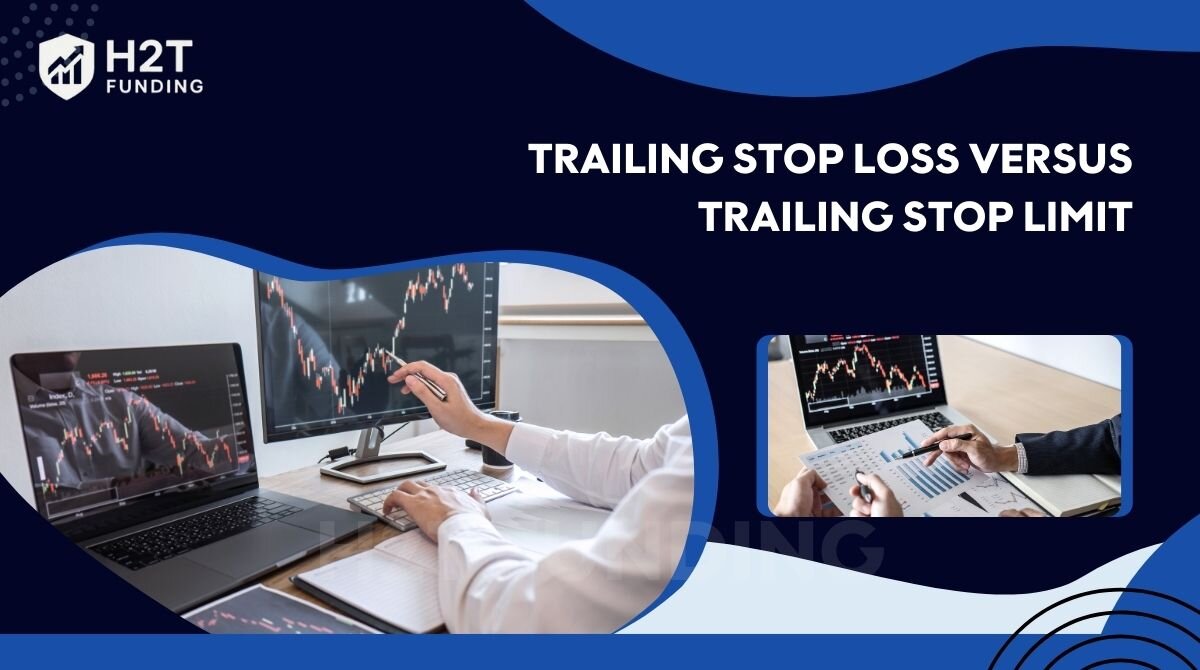In Forex trading, controlling risk and protecting profits is crucial. While the basic stop loss is an essential tool, its fixed nature makes adapting to market changes difficult, sometimes leading us to miss better profit opportunities or face unnecessary losing reversals.
Surely, many traders have felt the frustration of watching a profitable position quickly return to break-even, or even turn into a loss, just because of a sudden market shift. Without proactive management tools, this happens all too often. That’s when advanced tools become truly essential.
This article from H2T Funding delves deep into two powerful, yet often misunderstood, concepts: trailing stop loss versus trailing stop limit. These sophisticated order types offer a more dynamic way to secure gains and mitigate downside risk as your trades move in your favor.
Key takeaways:
- A trailing stop loss automatically follows the market price and triggers a market order, ensuring execution, but exposing you to potential slippage.
- A trailing stop limit combines dynamic adjustment with a limit order, providing more price control but also risking non-execution.
- Best use cases: A trailing stop loss is suitable for strong trends and swing trades, while a trailing stop limit is better suited for volatile markets, illiquid assets, or when precise exit prices are crucial.
- Common mistakes include setting trailing distances too tight/loose, misunderstanding order mechanics, and ignoring market conditions.
- No one-size-fits-all: the choice depends on your trading style, risk tolerance, and market environment. Testing both on a demo account is highly recommended.
1. Trailing stop loss: The following stop order
When engaging in Forex trading, the ability to adapt your exit strategy as a trade progresses is crucial. A standard stop loss sets a fixed point, but what if the market moves significantly in your favor? This is where the trailing stop loss comes into play, offering a dynamic solution.
1.1. What is a trailing stop loss?
A trailing stop loss is a type of stop order that automatically adjusts its price as the market price of an asset moves in a favorable direction. Unlike a fixed stop loss, which remains stationary, a trailing stop loss trails the market price by a specified distance.
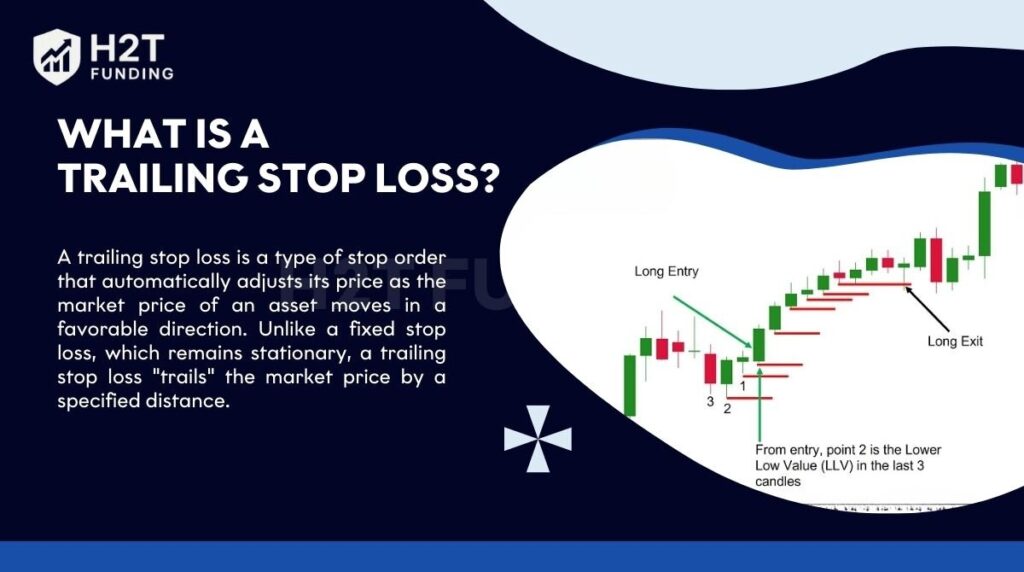
This distance is typically set in pips or a percentage. The key characteristic is that the stop price only moves in one direction – the direction that locks in more profit or reduces potential loss.
1.2. How a trailing stop loss works
Imagine you’ve just entered a long (buy) position on EUR/USD, and the market is moving exactly as you predicted. What an incredible feeling! You’ve wisely set a trailing stop loss at 20 pips below your entry price. As the price of EUR/USD soars, your stop loss magically follows it upward, always maintaining that safe 20-pip distance from the highest point reached.
Then, if the market decides to take a breather and reverse, your trailing stop loss acts as your loyal protector. It locks in place at its highest adjusted point, preserving the gains you’ve worked so hard for. When the price hits this adjusted stop loss level, your trade is automatically closed, and you get to walk away with a guaranteed portion of the profits.
This isn’t just about limiting your downside; it’s about confidently securing your success, allowing you to breathe easy and enjoy the fruits of your smart decisions. This is the true power of trailing stop loss versus trailing stop limit, thinking it’s about proactive victory, not just reactive defense.
1.3. Advantages and disadvantages of trailing stop loss
Understanding the pros and cons helps you decide when this tool is appropriate.
- Advantages:
- Profit optimization: It allows you to ride a strong trend, potentially capturing larger profits than a fixed stop loss.
- Reduced emotional bias: The automatic adjustment helps remove emotional decisions from trade management.
- Profit protection: It secures a portion of your profits as the trade moves favorably, preventing a winning trade from turning into a loser.
- Disadvantages:
- Premature exit in volatile markets: In choppy or ranging markets, small price fluctuations can trigger the trailing stop, leading to early exits.
- No guaranteed execution price: Like a market order, the trailing stop loss executes at the best available market price, which can lead to slippage, especially during high volatility or low liquidity.
1.4. When to use a trailing stop loss?
Based on its characteristics, a trailing stop loss is particularly effective in specific market conditions and trading strategies.
- Strong trending markets: It excels when the market is moving decisively in one direction, allowing you to maximize gains.
- Trend-following strategies: Traders who aim to capture long-term trends find this tool invaluable for managing their positions.
- Swing trading: For trades held over several days or weeks, a trailing stop loss can help protect accumulated profits without constant manual adjustment.
- When you cannot monitor the market continuously, its automated nature makes it ideal for traders who cannot watch their screens all day.
View more:
2. Trailing stop limit: Controlling the exit price, protecting your position
While the trailing stop loss offers a beautiful kind of flexibility, some traders find themselves yearning for more precise control over their exit price, a desire born from countless moments of market frustration.
This is where the trailing stop limit order swoops in like a hero, finally blending the dynamic adjustment of a trailing stop with the unwavering exactness of a limit order. It’s the answer to that sinking feeling of watching a perfectly good trade slip away due to slippage.
2.1. What is a trailing stop limit?
A trailing stop limit is a more advanced order type that also trails the market price, but instead of triggering a market order, it triggers a limit order. This means it has two components: a stop price (trigger price) and a limit price.
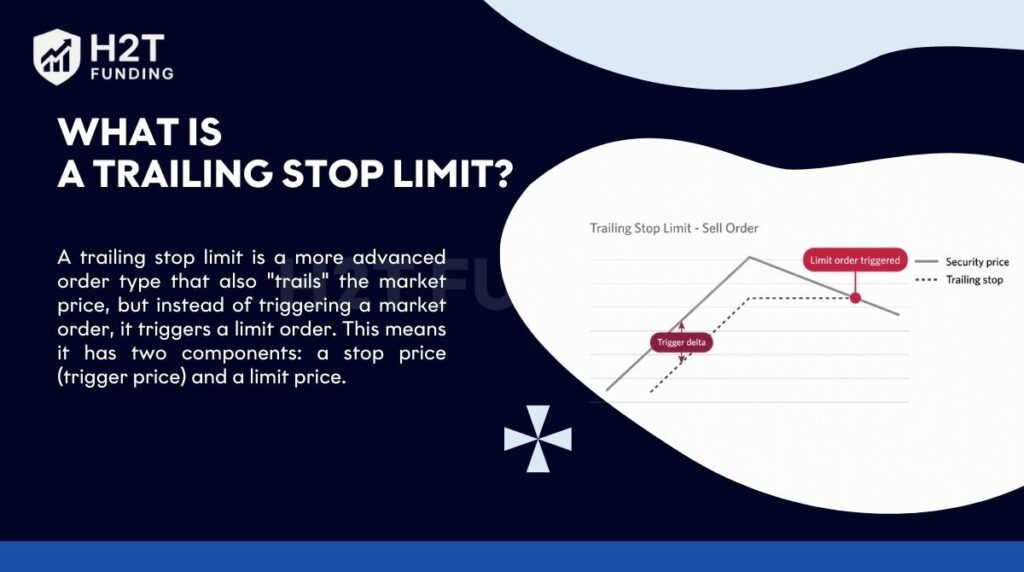
When the market price reaches the dynamically adjusted stop price, a limit order is placed at the corresponding limit price. This provides a defined range within which your trade will be closed, giving you more control over the execution price.
2.2. How a trailing stop limit works
Let’s dive into a short (sell) position on USD/JPY, a moment that can be filled with both hope and dread. You’ve smartly armed yourself with a trailing stop limit, setting it with a generous stop distance of 20 pips and a tight limit offset of 5 pips.
As USD/JPY plummets, a smile spreads across your face as you watch your trailing stop price diligently follow it down, always a comforting 20 pips above the lowest point. Your limit price also mirrors this descent, a reliable 5 pips above the stop price.
But then, the market betrays you with a sudden, sharp spike. The USD/JPY starts to rise, threatening your profits. When it hits your trailing stop price, a limit order to buy is instantly placed at your trailing limit price. This isn’t just an automated exit; it’s a defensive fortress.
Your trade will only close if the market price is at or better than your limit price. This isn’t a risky gamble with slippage; it’s a defiant stand against an unfavorable fill. It’s the moment you realize the true, empowering difference between trailing stop loss versus trailing stop limit. It’s about being in control, not at the mercy of the market’s whims.
2.3. Advantages and disadvantages of trailing stop limit
Understanding the trade-offs is crucial for effective application.
- Advantages:
- Better price control: It offers more certainty over the execution price, reducing the risk of significant slippage.
- Useful in volatile markets: It can be particularly beneficial during news events or periods of high volatility where large price gaps can occur.
- Protection against unfavorable fills: It prevents your order from being filled at an undesirable price if the market moves too quickly past your stop.
- Disadvantages:
- Risk of non-execution: The primary drawback is that your order might not be filled if the market price moves beyond your limit price too rapidly.
- Increased complexity: It is more challenging to set up and understand compared to a simple trailing stop loss, especially for novice traders.
- Requires market understanding: You need a good grasp of typical price ranges and volatility to set an appropriate limit offset.
2.4. When to use a trailing stop limit?
This order type is suited for specific scenarios where price precision is paramount.
- Markets are prone to large gaps or sudden spikes when trading during earnings reports, central bank announcements, or other high-impact news.
- Illiquid assets or wide spreads: For currency pairs with lower trading volume or wider bid-ask spreads, where slippage can be substantial.
- When a specific exit price is critical: If you have a precise profit target or risk tolerance that demands execution within a narrow price range.
- Short-term trading (scalping/day trading): Where even small amounts of slippage can significantly impact profitability.
3. Trailing stop loss versus trailing stop limit: A detailed comparison
So, faced with a trailing stop loss versus a trailing stop limit, how do you pick? It’s not about which one is strictly ‘better,’ but rather which tool aligns with your strategy and the current market environment. Let’s look at the clear distinctions.
For new traders, exploring the best trading strategy for beginners can also provide a solid foundation before deciding which risk management tool fits best.
3.1. Comparison table: Trailing stop loss vs. trailing stop limit
For an easier overview, let’s look at a quick comparison table for trailing stop loss vs trailing stop limit below:
| Feature | Trailing stop loss | Trailing stop limit |
|---|---|---|
| Mechanism | Triggers a market order | Triggers a limit order within a specified range |
| Execution | High certainty of execution | Risk of non-execution if the price moves too fast |
| Price control | No control over final execution price (market price) | High control over execution price (within a limited range) |
| Market suitability | Trending markets, less volatile periods | Volatile markets, news events, and illiquid assets |
| Complexity | Simpler to understand and implement | More complex, requires setting two price points |
| Primary risk | Slippage, premature exit in choppy markets | Order not being filled |
3.2. Which choice is better for your trading strategy?
The optimal choice between a trailing stop loss versus a trailing stop limit depends heavily on your individual trading profile and the specific trade context. There is no one-size-fits-all answer.
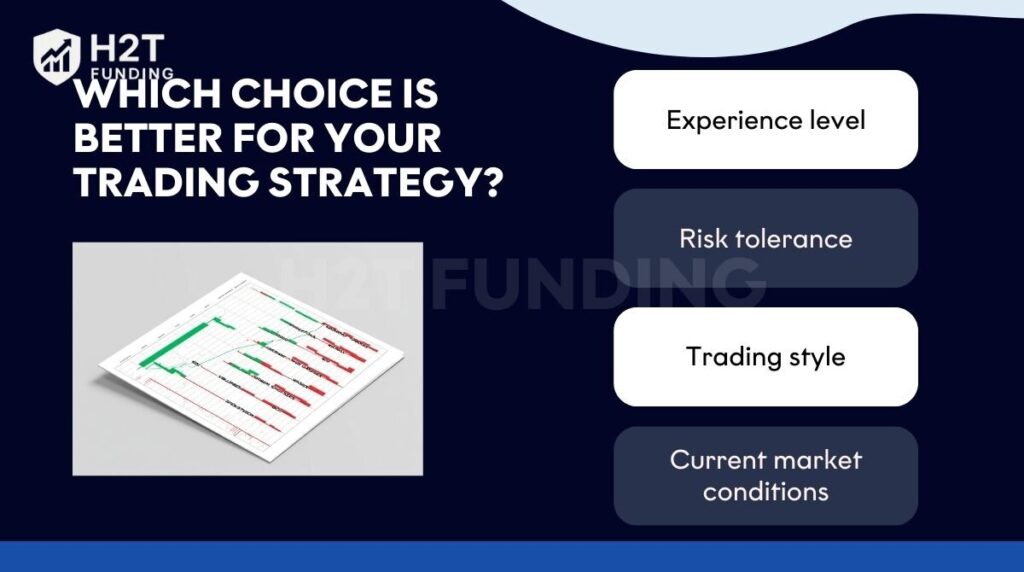
- Experience level: For newer traders, the simplicity of a trailing stop loss is often a great place to start. Its direct function helps them get a feel for dynamic risk management without unnecessary complications.
- Risk tolerance: If you prioritize guaranteed execution over precise price control, especially in fast-moving markets, a trailing stop loss is generally preferred. Conversely, if avoiding significant slippage is paramount, even at the risk of missing a fill, the trailing stop limit offers that precision.
- Trading style: Scalpers and day traders, who often deal with rapid price movements and tight margins, might lean towards a trailing stop limit for its price control. Swing traders, aiming for larger moves, might find the trailing stop loss more suitable for riding trends.
- Current market conditions: In highly volatile periods or around major news releases, the risk of slippage with a trailing stop loss increases. This is when a trailing stop limit can provide a safeguard against unfavorable fills, assuming the market stays within your specified limit.
I believe that no single tool is universally superior. Instead, the most effective tool is the one that best fits your trading style and the current market environment. Experimenting with both on a demo account is a practical way to determine which works best for you.
4. Common mistakes when using trailing stops and how to fix them
I’ve been there setting up trailing stops with high hopes, only to watch them backfire because of a simple oversight. Whether it’s getting stopped out too early or giving back hard-earned profits, these mistakes can sting.
Even after mastering the concepts of trailing stop loss versus trailing stop limit, I’ve seen traders, including myself, stumble into errors that significantly reduce their effectiveness.
Recognizing and fixing these common pitfalls is vital for using these tools successfully. This section highlights the typical mistakes I’ve encountered and offers practical ways to help you navigate them.
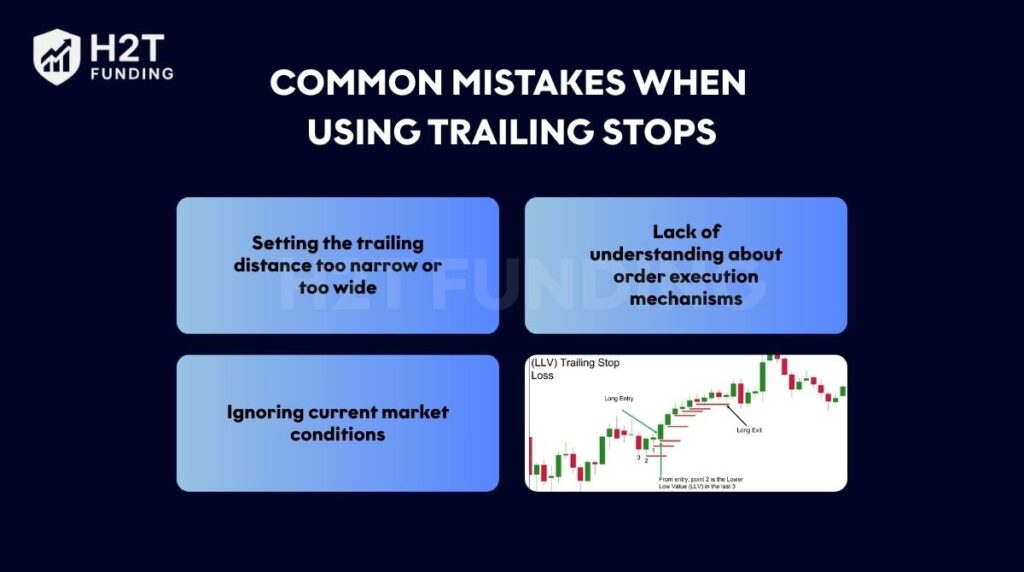
4.1. Setting the trailing distance too narrow or too wide
One of the most frequent errors is misjudging the appropriate trailing distance.
- Too narrow: A trailing stop set too close to the current price can lead to premature exits. Minor market fluctuations, often referred to as “noise,” can trigger the stop, closing your profitable trade before it has a chance to develop further. This can be frustrating, especially when the market resumes its original direction shortly after your exit.
- Too wide: Conversely, a trailing stop set too far from the price can negate its purpose of protecting profits. If the market reverses sharply, a wide trailing distance means you could give back a significant portion of your accumulated gains before the stop is triggered.
How to fix: Consider using indicators like Average True Range (ATR) to determine a dynamic trailing distance that adapts to current market volatility. You can also place your trailing stop beyond significant support or resistance levels, giving your trade more room to breathe while still providing protection.
4.2. Lack of understanding about order execution mechanisms
Many traders fail to fully grasp how market orders and limit orders behave, especially under different market conditions. This can lead to unexpected outcomes when a trailing stop is triggered.
- Slippage with trailing stop loss: Since a trailing stop loss triggers a market order, it will be filled at the best available price. In fast-moving markets, this can be significantly different from the stop price, resulting in slippage.
- Non-execution with trailing stop limit: With a trailing stop limit, if the market moves past your specified limit price too quickly, your order may not be filled at all. This leaves you in an open position you intended to close.
How to fix: Always be aware of the order type triggered by your trailing stop. For trailing stop loss, understand that slippage is a possibility and factor it into your risk management. For a trailing stop limit, ensure your limit offset provides enough room for the order to be filled, especially during anticipated volatility.
4.3. Ignoring current market conditions
Applying a rigid trailing stop strategy without considering the prevailing market environment is a recipe for suboptimal results. A strategy that works well in a strong trend might fail miserably in a ranging or choppy market.
- Using trailing stops in ranging markets: In a market without a clear direction, a trailing stop will likely be hit repeatedly, leading to a series of small losses or missed opportunities.
- Not adjusting for news events: Major economic news releases can cause extreme volatility and large price swings. Using a standard trailing stop during these times without adjustment can lead to significant slippage or premature exits.
How to fix: Be flexible with your trailing stop strategy. In ranging markets, consider using different exit strategies or avoiding dynamic stops altogether. Before high-impact news, you might adjust your trailing distance or consider using a trailing stop limit for better price control if you choose to remain in a trade. Always adapt your tools to the market, not the other way around.
Read more:
5. Frequently asked questions (FAQs)
A trailing stop triggers a market order for immediate execution. A trailing stop limit triggers a limit order, which fills only at or better than a specified price, risking non-execution for price control.
Neither is inherently better; it depends on your priority. A stop loss guarantees execution (with potential slippage), crucial for immediate exits. A stop limit offers price control but risks not being filled if the market moves too fast.
Yes, many professionals use trailing stop-loss to protect profits and manage positions, especially in trending markets. However, they often combine it with discretionary adjustments and active market analysis.
There’s no single best method. Popular approaches include fixed pips/percentage, Average True Range (ATR), moving averages (MA), and swing highs/lows. The most effective method aligns with your strategy and is thoroughly backtested.
6. Conclusion
Understanding the nuances of trailing stop loss versus trailing stop limit is a crucial step for you to truly master your risk management and protect your trading profits. These are flexible tools that help you protect your capital and maximize gains in an ever-changing market like Forex.
Choosing the right tool truly depends on your individual trading style, risk tolerance, and the specific market conditions you are navigating. It is not about finding a magic bullet, but rather about equipping yourself with the knowledge to make informed decisions.
- Always prioritize continuous learning and practice.
- Experiment with both order types on a demo account to see how they behave in real-time.
- Adapt your strategy based on market volatility and your personal trading goals.
At H2T Funding, we believe that consistent education is the cornerstone of successful trading. Explore more in our Prop Firm & Trading Strategies section for in-depth insights into advanced trading concepts.

